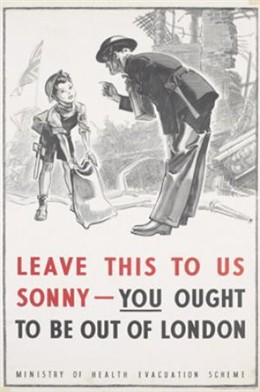Child Evacuees at Victoria Station

Ministry of Health Evacuation Scheme poster
Copyright Imperial War Museum
September 1939
By Sarah Boyle based on original research by Hamish McGillivray
At the start of World War II around one million children were evacuated from their homes in London and from other British cities. The British government referred to the evacuation as “the biggest exodus since Moses.” The government ordered “Evacuate Forthwith” on 31 August 1939 and the children began their journeys the following day. In London alone there were 68 designated departure points.
Wealthy families were able to make their own plans and children who attended private school were sent to manor houses in the countryside. During this uncertain time, children were forced to live with strangers whilst wondering about the wellbeing of their loved ones still in Central London. One observer, writing under the name KB, records the confusion at Victoria Station in September 1939 between 12.30pm and 14.00pm. The first school parties to arrive that day walked in from Eccleston Street and were instructed to wait on platforms 16 and 17. At the end of the platforms were railings with parents leaning over waiting to say goodbye. KB notes “ no one who is not with theschool parties is allowed on the platforms. About 10 policemen and women around, two at the barrier.”1
KB then makes a note that he/she couldn’t help but cry during the first 20 minutes at the sight of children merrily saying goodbye while their parents’ heads are filled with concerns as to when and if they will ever get to see them again. Parties arrived every 30 minutes that day. An excerpt from KB’s detailed notes clearly paints a picture of the tone of Victoria station:
“12.30 a party of elementary school children have just come in and on the platform, girls and boys. There are about 200 people waiting near the barrier, and about 80% of these are women. When observer arrives the “Chesnut Tree” is in full blast. Children are singing full voices and with a swing with it. The sound fills all that part of the station. Women are quiet and all gaze towards the platform, some mopping eyes with handkerchiefs...”1
Just a short while later, Buckingham Gate School arrives at 12.35.
“They march in through the entrance a big girl in front carrying the banner “L.C.C Buckingham Gate”. The children march in twos but not rigidly, ranks slightly uneven. Girls and boys together. They carry shoe-bags bulging and stuffed full, haversacks on backs, some with blazers rolled up and tucked through the straps of haversacks. Some have paper parcels, cases, and one a net bag of tennis balls. Gas masks in cardboard boxes slung round their necks with string and under the arm, so that each child has bundles of one sort or another hung round it in all directions."1
KB notes that one in four mothers are crying and that all the parents look tired. Between the summer heat and stress of the day, everyone is very hot. It is impossible to come up with a comparable situation of the day to describe the atmosphere on the platforms. The striking contrast between the ordinary attitude of the children juxtaposed with that of the emotions of the parents is awkward to say the least. Stuck between the two attitudes is the calm of the schoolteachers and the police. When the expected raids didn’t happen, children returned home. After the “Phoney War" (September 1939 to April 1940) nearly half the children originally evacuated returned.
1 Copyright Mass Observation Archives